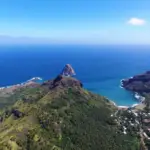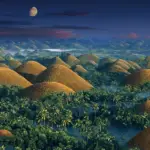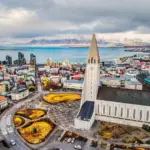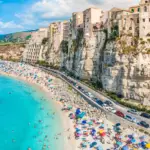
Located in the northwest region of Madagascar, you Tsingy de Bemaraha are one of the most impressive landscapes in the world. Composed of a complex network of sharp, jagged rocks, the Tsingy de Bemaraha is a veritable field of limestone speleothems. This magnificent rock formation was declared a UNESCO World Heritage Site in 1990.
Main Conclusions
- You Tsingy de Bemaraha are a landscape of sharp rocks located in Madagascar
- This rock formation is a speleothem field of limestone rocks
- The Tsingy de Bemaraha were declared a UNESCO World Heritage Site in 1990
What are the Tsingy de Bemaraha
The Tsingy de Bemaraha are a unique geological formation in Madagascar, characterized by an intricate network of sharp limestone peaks extending over more than 150,000 hectares. Geologists believe the formation of the Tsingy de Bemaraha began about 200 million years ago, when the region experienced volcanic activity. Rainwater and subsequent erosion sculpted these limestone rocks into distinctive and unusual shapes that attract the attention of tourists and scientists.
The name Tsingy de Bemaraha comes from the local Malagasy language and means “where one cannot walk barefoot,” a reference to the sharp edges of the rocks that can pierce shoe soles and even car tires.
Among the characteristics The most notable of the Tsingy de Bemaraha are the “Tsingy” forests that grow on top of the rocks, sheltering species of plants and animals that are unique of this region. These forests, the fauna and flora unique and the impressive view that the rock formations provide are some of the main attractions of this tourist destination.
Location of the Tsingy de Bemaraha in Madagascar: How to get there
The Tsingy de Bemaraha are located in western Madagascar, in the Melaky region. The most common way to get there is by trip by car from the capital, Antananarivo. The drive takes about 10 to 12 hours, depending on road conditions, which can be a bit tiring. Another option is to fly to Morondava and then drive about 150 km to the Tsingy de Bemaraha.
For those who prefer a more adventurous option, there's also the option of getting there via a boat journey along the Tsiribihina River. This option is longer and takes about 2 to 3 days, but it can be a incredible experience for those who love to explore new places differently.

Flora and Fauna of the Tsingy de Bemaraha
Madagascar's Tsingy de Bemaraha National Park is a stunning nature reserve, home to a rich biodiversity of flora and fauna.
The Tsingy area is characterized by an arid environment with many sharp rocks, but even so, the region surprises with the variety of animal and plant species.
Among the species of fauna, the lemurs stand out, very common in Madagascar, and which can be seen in the trails of the park. Other animals found in the area include various types of bats, reptiles, amphibians, and birds, many of which are endemic to the region.
Concerning flora, the Tsingy area features vegetation adapted to water scarcity, such as cacti, succulents, and small trees like baobabs. Additionally, it's possible to find orchids, bromeliads, and other plants growing among the rocks.
The richness of animal and plant species in the Tsingy de Bemaraha is a demonstration of the importance from this area to the biodiversity global. It is essential to preserve this unique region in Madagascar, protecting the species that live here.

Adventures in Tsingy de Bemaraha
The Tsingy de Bemaraha are an impressive landscape and offer many adventures exciting for visitors. One of the most popular ways to explore this area is through its trails winding paths that pass between sharp rocks and thickets of forests.
To the trails offer different levels of difficulty, from simple hikes to climbing steep rock faces. The local residents offer guide services, which are highly recommended for visitors who wish to explore more challenging areas.
Besides the trails, there are other exciting activities to try, such as ziplining, which allows you to admire the landscape from above, as well as kayaking and rappelling. There's something for all levels of enthusiasm and experience.
However, it's important to remember that safety is always the number one priority. Be sure to follow all recommended safety precautions and listen to your local guide's instructions.
Importance and preservation of the Tsingy de Bemaraha
The Tsingy de Bemaraha are one of the most impressive landscapes in Madagascar and have a large importance ecological and geological. This area is home to a large biodiversity, with several endemic species that can only be found there.
Furthermore, the Tsingy de Bemaraha were formed over thousands of years by unique geological processes, making them a true natural work of art. For this reason, it is crucial that this area be preserved and conserved for future generations.
With the growing interest in tourism in Madagascar, it is important to consider the impact of tourism in the Tsingy de Bemaraha. Human activities such as road construction and removal of native species can affect the sustainability of the area. Therefore, it is essential to develop sustainable tourism practices that respect the natural landscape and minimize negative impacts.
THE preservation and conservation The Tsingy de Bemaraha is a collaborative effort between governments, non-governmental organizations, and the local population. It is necessary to invest in initiatives aimed at protecting the area and raising awareness among all stakeholders about the importance to maintain this natural wonder for future generations.

Best time to visit the Tsingy de Bemaraha
If you plan to visit the Tsingy de Bemaraha, it is important to choose the best time for the best possible experience. The good news is that you can visit Madagascar's cutting stones year-round.
However, it is important to remember that the climate in Madagascar can vary greatly depending on the region of the country. In general, best time to visit the Tsingy de Bemaraha is during the dry season, from April to November.
This season is characterized by pleasant temperatures, blue skies, and little rainfall. During the rainy season, from December to March, access roads can become impassable and weather conditions can disrupt your travels. adventures on the sharp stones.
Additionally, Madagascar's peak tourist season is from July to August, so if you prefer a quieter environment, avoid traveling during this time. If you're a bird lover, best time for birdwatching is from November to April, during the breeding season.
Tips for exploring the Tsingy de Bemaraha
If you plan to visit the Tsingy de Bemaraha, there are a few tips important things that can help make your trip more pleasant and safe. Below, we list some suggestions useful:
1. Plan your visit in advance
The Tsingy de Bemaraha are a popular tourist destination in Madagascar, so it's important to plan your visit carefully. This includes researching the best times to visit, booking accommodations and local guides in advance, and planning a comprehensive itinerary with the attractions you want to visit.
2. Get the right equipment
Exploring the Tsingy de Bemaraha may require specific equipment, such as comfortable shoes with good grip, lightweight, sturdy clothing, a helmet, and climbing gear. Make sure you've acquired everything you need beforehand. trip and test it before reaching the destination.
3. Hire a local guide
The Tsingy de Bemaraha is a unique and complex landscape, and a local guide can help make your visit safer and more enjoyable. They know the area well and can provide information on the region's history, geology, and wildlife.
4. Respect nature
It's important to remember that the Tsingy de Bemaraha is a protected natural area, and visitors should respect the local flora and fauna. Don't leave trash on the trail, stay on permitted trails, and don't touch any wild animals you might encounter.
5. Be prepared for weather conditions
The Tsingy de Bemaraha can be very hot during the day and very cold at night, especially during the dry season. Be sure to bring sunscreen, sunglasses, a hat, and appropriate clothing to protect yourself from the sun. At night, you may need a sweater to stay warm.
6. Enjoy activities safely
When exploring the Tsingy de Bemaraha, it's important to follow safety rules and wear protective equipment when necessary. This includes helmets, ropes, and climbing gear. If you've never climbed before, it's important to familiarize yourself with the basic techniques before attempting to climb the Tsingy de Bemaraha.
Now that you know some tips useful, you are ready to explore the Tsingy de Bemaraha and make the most of your trip.

The impact of tourism on Tsingy de Bemaraha
While tourism is a great way to promote the natural beauty of the Tsingy de Bemaraha to visitors from around the world, it can also have a negative impact on the environment if not approached sustainably.
You tourist spots Popular communities often face many challenges, including excessive waste, heavy traffic, and biodiversity loss. The Tsingy de Bemaraha is no exception.
However, the good news is that many local tourism agencies, organizations, and individuals are committed to minimizing the negative impacts of tourism and preserving the natural beauty of the Tsingy de Bemaraha.
Some examples of initiatives sustainability include:
- Training tour guides to provide accurate information about local flora and fauna and encourage sustainable practices for visitors.
- Reducing the use of disposable plastics and encouraging recycling at all tourist attractions.
- Minimizing the use of motorized vehicles and encouraging the use of alternative transportation, such as bicycles and walking.
- Establishment of restricted areas to preserve local biodiversity and minimize human impact on sensitive areas.
Therefore, it is important that visitors to the Tsingy de Bemaraha are conscious of their actions and look for ways to minimize their environmental impact during their stay. adventures in the region. After all, preserving the biodiversity and natural beauty of the Tsingy de Bemaraha is essential to maintaining this unique and incredible tourist destination for many years to come.

Conclusion
The Tsingy de Bemaraha are a unique and impressive landscape worth exploring and preserving. We hope this article has provided useful information and inspired readers to explore this area. natural wonder in Madagascar.
Besides being a exciting experience, visiting the Tsingy de Bemaraha is also an opportunity to learn about the importance of conservation environmental. The region's biodiversity is a treasure to be preserved, and awareness of importance of sustainable tourism is essential to protect it.
Therefore, we encourage everyone to visit the Tsingy de Bemaraha responsibly and respectfully. Enjoy the trails, climbs, and other exciting activities the region offers, but remember to minimize your impact on nature and contribute to the conservation of preservation of this unique landscape for future generations.
FAQ
What are the Tsingy of Bemaraha?
The Tsingy de Bemaraha are a stunning landscape of sharp rocks located in Madagascar. This unique rock formation is characterized by its sharp needles, which have been sculpted by erosion over millions of years.
Where are the Tsingy de Bemaraha located?
The Tsingy de Bemaraha are located in Madagascar, specifically in the Melaky region. This area is part of the Tsingy de Bemaraha National Park and covers an area of approximately 1,575 square kilometers.
What are the characteristics of the Tsingy de Bemaraha?
The Tsingy de Bemaraha are characterized by their sharp, pointed rock formations. These limestone needles can reach impressive heights and form a spectacular and unique landscape. Furthermore, this area is home to a rich diversity of endemic flora and fauna.
What activities can visitors do at the Tsingy de Bemaraha?
Visitors to the Tsingy de Bemaraha can enjoy a variety of exciting activities, including hiking, climbing, and observing the flora and fauna. There are several marked trails that allow you to explore this incredible landscape and discover its natural beauty.
What is the best time to visit the Tsingy de Bemaraha?
The best time to visit the Tsingy de Bemaraha is during the months of April to November, when the climate It's milder, and there's less chance of rain. This is also Madagascar's dry season, making it easier to explore the Tsingy.
What are your tips for exploring the Tsingy de Bemaraha?
To explore the Tsingy de Bemaraha, it's recommended to be prepared with appropriate equipment, such as light clothing, comfortable shoes, and sunscreen. It's also advisable to hire an experienced local guide who knows the region well and can help you explore.
What is the impact of tourism on the Tsingy de Bemaraha?
Tourism can have a significant impact on the Tsingy de Bemaraha, but it is crucial that it be carried out sustainably and responsibly. preservation of this unique area is essential to ensure your conservation in the long term, therefore, it is important that visitors follow visiting guidelines and respect the environment.
Lucas Wanderlust has a tireless spirit of adventure, always seeking new travel experiences. Fascinated by the world and the possibility of exploring unknown destinations, he fell in love with the sense of freedom and self-discovery that traveling alone provides. With a backpack on his back and a heart open to the unknown, Lucas embarks on exciting journeys, where each destination becomes a unique chapter in his life story. He gives himself body and soul to the magic of solo travel, inspiring others to follow in his footsteps and discover themselves through adventure.







